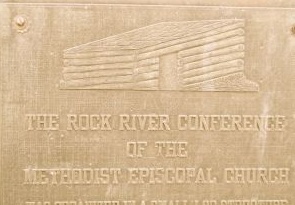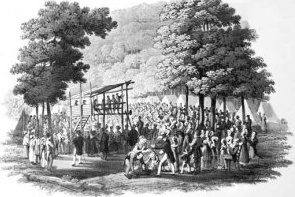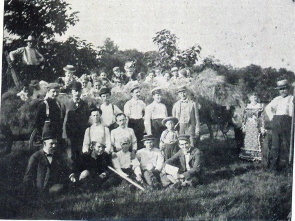Dr. King Wanted to Build a Better World, Not a Monument
In his reflection, Rev. Dr. Charles A. Woolery Sr., challenges readers to move beyond a comfortable, sanitized remembrance of Rev. Dr. Martin Luther King Jr. to engage hi…

The first session of the Rock River Conference of the Methodist Episcopal Church met in Mt. Morris, Illinois beginning August 26, 1840. Why Mt. Morris? Why not Chicago, or Rockford, or . . . ?
The demographics were different then. Galena was the second most populous location in the state after Alton. Rockford was known as midway, a small village halfway between Chicago and Galena. After a brief canal-boom in the logcabinplaque1830’s, Chicago had been hit by the Panic of 1837 and was far from recovered. At an era of boosterism, when any new settlement could call itself Athens, or Oxford, or Zion, or Antioch in hope of a great future, Mt. Morris was as good as any.
Besides, Mt. Morris was a Methodist town. The Hitt family lived there. They were long-time Methodists from the east, mostly from Maryland (Mt. Morris was originally the Maryland Colony). Members of the Hitt family had known and traveled with Francis Asbury. Many other Methodists from the east also settled in the area, often coming in groups. Mt. Morris was named for a Methodist bishop (Thomas Morris). Its dirt streets were named for such Methodist notables as Hitt, Asbury, McKendree, Clark, and, of course, Wesley.

Mt. Morris was building the first Methodist educational institution in the region, the Rock River Seminary (a pre-collegiate/collegiate institution rather than a school for clergy, though a number of preachers received an education there). The Illinois Conference had formed a committee in 1838 to select a site in the northern part of the state. The committee invited bids from Joliet, Mt. Morris, St. Charles, Geneva, Elgin, Rockford, and Kishwaukee to offer funds and land for the school. Roscoe, Kishwaukee, and Mt. Morris responded. Mt. Morris won, and construction began. The town promised a fine setting in one of the new academic halls and congenial surroundings dominated by Methodists.
Traveling by Wagon, Carriage, and Horseback
Mt. Morris was a bit far, especially for presiding Bishop Beverly Waugh. In a day when bishops were itinerating general superintendents over the whole connection, the bishop officiated at the Michigan Conference, then made his way by coach, open wagon, carriage, and steamboat to Chicago (which he could not say “equaled my expectations;” though he did see signs of improvement). From Chicago, he traveled by wagon over the prairie to Mt. Morris. He was impressed by the variety and beauty of the vegetation, but “the monotony of the scene soon becomes tiresome.” After the session in Mt. Morris, he moved on to officiate at the Illinois Conference. He was 51 years old—not young for a time when the average life expectancy was 40 something, and certainly not young for such strenuous travel.
Mt. Morris was distant even for the preachers. The original bounds of the conference covered Northern Illinois, Iowa, Wisconsin, and parts of Minnesota. The preachers traveled from near and far, largely on horseback, to attend the meeting in Mt. Morris. The Conference had been promised a first class meeting space in the new Rock River Seminary. Unfortunately, the new lecture hall was not ready, so the conference met in the next largest space, a former pioneer cabin.
Waugh described the location as “a log cabin, but I should rather call it a log pen. It was somewhat in the form of a shed, with a large opening in the south end of it, which was designed for an entrance. The lowest side of the pen was seven logs high; the highest perhaps two logs more. Some of the larger openings were filled with smaller timbers, but more of them were left open for light and air. It was covered with pieces of an old roof spread over the top. It was carpeted with straw. As it was not airtight, so it was not waterproof.” The weather was wet. The Conference Secretary, Benjamin T. Kavanaugh, had trouble keeping the Conference papers dry. It is not surprising that the first purchase authorized by the session was a trunk to contain the Conference records.
The interior dimensions of the “shed” were 12 feet by 18 feet. The Bishop, twenty-two elders, along with deacons, candidates, and guests crammed into the cabin for
the first session of the Rock River Conference.
First Conference Members
There were fourteen Elders and eight Deacons who traveled from northern Illinois, Wisconsin, and parts of Minnesota (the then bounds of the Conference). Only the traveling preachers were members. All were men. Though a frequent subject of debate and the occasion of the Methodist Protestant succession in the 1820s, lay membership in Methodist Episcopal conferences was still decades away.
Even local preachers who had once been part of the traveling connection were not usually seated, except in an honorary capacity. Most of the preachers were young (in their twenties and thirties). The rigors of Methodist ministry had always favored youth. However, older conferences back East had begun to develop a cadre of seniors. On the other hand, Bishops and others recruited young men for appointments on the frontier. For instance, Hooper Crews was 24 years old when appointed to the Galena circuit (at a time when Galena was the second largest town in the state). Thus, when a new conference was formed in frontier territory, it had the effect of skewing the average age downward. There were also some surprises. In the printed minutes, George Copway is listed as a Deacon and Henry P. Chase as a candidate for ordination. In both cases, a parenthetical note identifies each as “an Indian brother.”

Sunday School outing, 1920'sKakegagahbow, aka George Copway, was a 22-year-old member of the Ojibwa nation. He was already a national figure, who came to Mt. Morris from a tour of eastern churches to preach and promote for the Ojibwa. He was already a Deacon. His cousin Pahtahquahong, aka Henry P. Chase, also 22, was ordained Deacon at the 1840 Conference. Kakegagahbow and Pahtahquahong were among a number of Ojibwa Methodists whose homeland spanned the U.S./Canadian border.
They, Pahtahsega (Peter Jacobs), Sowingisik/George Kachenooting (Henry Bird Steinahauer), Kezhegowinninne (David Sawyer), and Shahwundais (John Sunday) affiliated across borders with both the Wesleyan Methodists of Canada and the Methodist Episcopal Church in the U.S. Kakegaghbow was an eloquent advocate for native homelands at the time when the policy of the American government was Indian removal–forced relocation of native peoples to lands west of the Mississippi River. Even as he lectured in favor of a native homeland northeast of that River, government agents were attempting to negotiate the resettlement of the Ojibwa.
Kakaegaghbow would often appear before his audiences in elements of Ojibwa dress. He had a following that included not only Methodists, who often opposed Federal Indian policy (including an opposition to removal), but many of the intellectual and literary figures of the day. In 1847 he published The Life, History, and Travels of Kah-ge-ga-gah-bowh (George Copway), which continues to be used as a primary source in academia. He briefly mentions attending the conference at Mt. Morris. In 1825, Jesse Walker was appointed missionary to the Indians and established a mission to the Potawatomi near Plainfield. By 1828, Salem mission was being closed. Though there was a significant Native American presence in Northern Illinois into the 1840’s, the Rock River Conference did not revive Walker’s efforts. The high turnover of the appointment system was not conducive to such missions.
*This is part two in a two-part series on our 175th anniversary. Read Part 1.
In his reflection, Rev. Dr. Charles A. Woolery Sr., challenges readers to move beyond a comfortable, sanitized remembrance of Rev. Dr. Martin Luther King Jr. to engage hi…
Clergy and lay members will gather June 14–16 in Schaumburg for the Northern Illinois Conference’s 187th Annual Conference, centered on the theme “Practicing Hope.” With inspiring worship, engaging…
Acknowledging the challenges of a fractured and uncertain time, Bishop Dan Schwerin lifts up gratitude for the resilience, courage, and faithfulness of the Northern Illinois Conferen…
Over the past year, the Northern Illinois Conference has supported local churches through a range of grants designed to nurture innovation, sustain vital rural ministries, and advanc…